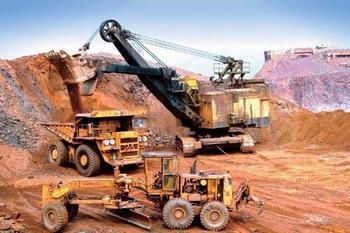 In a significant move that could reshape the global iron ore market, the Chinese government has introduced new regulations requiring all iron ore importers to register on the Beijing International Mining Exchange (CBMX) in order to obtain import permits. This policy marks another step in China’s effort to gain greater control over iron ore pricing and supply chains.
According to recent data, China accounts for roughly two-thirds of the world’s seaborne iron ore trade—over 1 billion tons annually. Since the collapse of the 40-year annual pricing mechanism in 2010, China has shifted toward a more flexible spot pricing model. Now, with these new rules, Beijing is pushing for more transparency and control by mandating that traders and steel mills must conduct at least 551,155 tons of iron ore transactions on CBMX to qualify for import licenses. Additionally, only Chinese companies are now eligible to apply for these permits.
The Beijing International Mining Exchange, launched as China’s first dedicated platform for iron ore trading, is expected to benefit from this regulation, gaining more liquidity and market share. It competes with Singapore-based GlobalOre, but with the new rules, CBMX may see a surge in activity. Major players such as Rio Tinto, BHP Billiton, Vale, and China’s Baoshan Iron and Steel have been active on both platforms, but the new policy could shift their operations toward CBMX.
This regulatory change comes amid growing concerns over price volatility and alleged market manipulation. Earlier this year, the National Development and Reform Commission filed a lawsuit against the world’s top three iron ore miners and several dealers, accusing them of inflating prices. The price of iron ore had risen sharply—from a three-month low in September last year to over $145 per ton in February—marking an increase of more than 80%.
Sources close to the matter suggest that traders are already adjusting their strategies, aiming to boost their transaction volumes on CBMX to meet the new requirements and secure import permits. As China continues to assert its influence in the global commodities market, these changes signal a broader push for domestic control and strategic advantage.
In a significant move that could reshape the global iron ore market, the Chinese government has introduced new regulations requiring all iron ore importers to register on the Beijing International Mining Exchange (CBMX) in order to obtain import permits. This policy marks another step in China’s effort to gain greater control over iron ore pricing and supply chains.
According to recent data, China accounts for roughly two-thirds of the world’s seaborne iron ore trade—over 1 billion tons annually. Since the collapse of the 40-year annual pricing mechanism in 2010, China has shifted toward a more flexible spot pricing model. Now, with these new rules, Beijing is pushing for more transparency and control by mandating that traders and steel mills must conduct at least 551,155 tons of iron ore transactions on CBMX to qualify for import licenses. Additionally, only Chinese companies are now eligible to apply for these permits.
The Beijing International Mining Exchange, launched as China’s first dedicated platform for iron ore trading, is expected to benefit from this regulation, gaining more liquidity and market share. It competes with Singapore-based GlobalOre, but with the new rules, CBMX may see a surge in activity. Major players such as Rio Tinto, BHP Billiton, Vale, and China’s Baoshan Iron and Steel have been active on both platforms, but the new policy could shift their operations toward CBMX.
This regulatory change comes amid growing concerns over price volatility and alleged market manipulation. Earlier this year, the National Development and Reform Commission filed a lawsuit against the world’s top three iron ore miners and several dealers, accusing them of inflating prices. The price of iron ore had risen sharply—from a three-month low in September last year to over $145 per ton in February—marking an increase of more than 80%.
Sources close to the matter suggest that traders are already adjusting their strategies, aiming to boost their transaction volumes on CBMX to meet the new requirements and secure import permits. As China continues to assert its influence in the global commodities market, these changes signal a broader push for domestic control and strategic advantage. lithium batteries are a class of batteries made of lithium metal or lithium alloy as positive/negative electrode materials and using a non-aqueous electrolyte solution. lithium batteries can be broadly divided into two categories: lithium metal batteries and lithium ion batteries.
Lithium metal batteries: These batteries contain lithium in the metallic state and are usually non-rechargeable. Due to the very active chemical properties of lithium metal, its processing, preservation and use have very high environmental requirements.
Lithium-ion batteries: These batteries do not contain lithium in the metallic state and can be recharged. Lithium-ion batteries mainly rely on the movement of lithium ions between the positive and negative electrodes to work, and when charging, lithium ions are removed from the positive electrode and embedded into the negative electrode through the electrolyte; The opposite is true for electrical discharge. Lithium-ion batteries have a voltage range of 2.8V to 4.2V, typical voltage is 3.7V, lower than 2.8V or higher than 4.2V will cause damage to the battery risk.
The invention of the lithium battery can be traced back to 1912, by Gilbert N. Lewis proposed and studied lithium metal batteries. Lithium-ion batteries, on the other hand, were started in the 1970s by M. S. Whittingham. With the development of science and technology, lithium battery has become the mainstream, especially in portable electronic equipment widely used.
Rechargeable Lithium Battery, Li-ion Battery, 18650 Lithium Battery
Guangdong Dp Co., Ltd. , https://www.dp-light.com